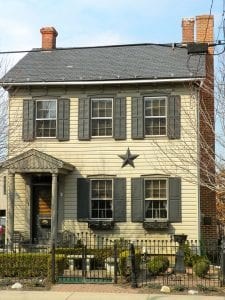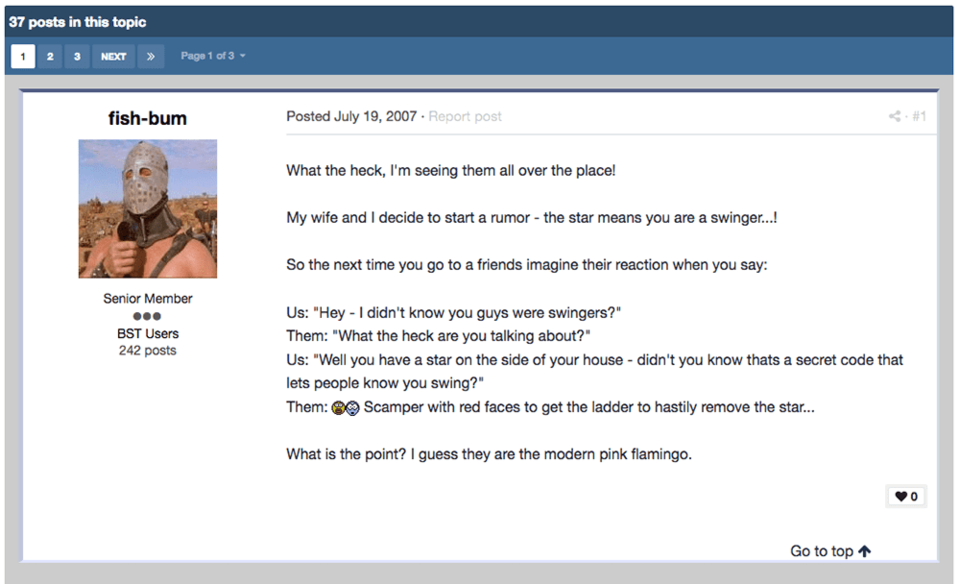Revisiting one of our most popular stories of all time, first published in 2018 and updated in 2020. Have a barn star photo you'd like to add to this article? Email it to us!
A signal to fellow swingers? Not exactly.
They are not noticeable until you notice one, and then you see them everywhere. Large, five-pointed stars are affixed to the walls of countless houses in Pelham, Ontario, often hanging at the tip-top of a front-facing gable.
The proper term for the emblem is “barn star,” even if it’s on a house rather than barns, and they are typically associated with the Pennsylvania Dutch.
“Pennsylvanian Dutch” is a term typically used to refer to emigrants from the Rhine area of Germany—Amish, Mennonites, and Lutherans who moved to the United States. Despite this general association, however, the precise origin of barn stars is unknown, though it appears that they had no explicitly Biblical associations.
According to the website Pioneer Thinking, “settlers painted colourful geometric patterns on their barns. Many were floral designs, birds and, stars, many of them look[ing] like a quilt patch. The people assigned specific meanings for each symbol. Somehow through time the geometric symbols evolved through the Pennsylvania Dutch farmers as 'hex' signs. They were to bring the families good luck.”

Barn stars became increasingly popular after the US Civil War, with some being aesthetic while others the mark of a specific barn’s builder. Geometric shapes have historically also been used in the dedication of great buildings. The original centre block of parliament had a star-shaped plaque placed by the Prince of Wales in 1860, which was salvaged following the fire and returned after the building’s reconstruction.
Ridgeville, Ont. residents Catherine and LaVerne Dickinson have a barn star on their house, and said that they thought of getting one after seeing them in the United States.
“They are everywhere in Vermont, and that is where we spend a month in October,” said Catherine. “We inquired when we purchased a few while in Vermont, and were told that the star signifies ‘Welcome.’ In Vermont where there are old barns everywhere, the stars on the houses or barns are more rustic than the one I painted on our house. They are usually a rust colour. I know that they date way back to horse and buggy days.”
In recent decades, barn stars have become mostly objects of decoration. A 2006 article in the Boston Globe focused on the fashionability of the decorations, and quoted several owners of them.
“The people at the store told me they started as Chinese good luck stars and were later adopted by the Amish with the same meaning," said one woman.
The Globe also cited an interior designer, who said that different styles of stars are now used for different purposes.
The people at the store told me they started as Chinese good luck stars and were later adopted by the Amish with the same meaning
“I've seen them used in repetitive patterns in urban environments, as well as in reserved country settings,” said the designer. “For example, the plain five-point star can be used to create a Western ranch-look, whereas a more elaborate—and rare—six-point star can be used to bring more formality to a space.”
The stars are sold widely online. One spot even offers them in American-flag decal along with hooks that affix to siding. There’s a colour-code for the stars, too. Black means protection, while blue means projection and peace. Red means emotion, passion, and charisma. Violet represents the sacred.
Metal Barn Stars boasts that they use “22 gauge galvanized metal (the thickness of a dime),” in their stars, so as “to ensure that our customers are purchasing the best quality barn star available and [it] won’t rust on you.”
“While many folks assign ‘meaning’ to the barn stars, we think that they are simply a wonderful decorative accent and that they look great on barns, homes, garages, or anywhere indoors,” reads the site’s explainer.
In 2018, the online craft market Etsy had hundreds of barn star listings, including a supposed “antique” three-foot star in California retailing for $497, plus $332 shipping to Canada. The listing assures potential buyers that the star was “handcrafted from raw steel,” and suggests that it’s “great for the big western-themed party events, country-themed events, for the cowboys and cowgirls and more.”
The buyer must hope that they love the star upon its arrival, since if not, “the buyer will be responsible to pay the return shipping cost as well as the 15 percent restock fee.”
Symbolism arises in mysterious ways. When European explorers arrived in South America, they encountered pineapple for the first time. According to the World Encyclopedia of Food, these explorers found that many indigenous peoples would hang the fruit on the their houses to demonstrate a welcoming to strangers.
As the fruit—and the concept—slowly entered Europe, pineapples came to represent hospitality for the gentry, and depictions of the fruit began popping up in common areas. The exorbitant cost of pineapples meant that some could be sold for as much as $8000 in current dollars in the United States, and there was even a pineapple-renting market for those who could only afford to show off the fruit for a short period of time.
What barn stars definitely are not is a secret sign to those living "the lifestyle," i.e., swingers—or, in really old-dude-speak, "wife-swappers." The swinger label seems to have originated in 2007, when a user on stripersonline.com—stripers, not strippers, a discussion board for all manner of fishing-related topics—apparently decided to start the unfounded rumour that stars equaled swingers.

While discussion on the site lasted all of one day, the rumour took on a life of its own. Among other collateral effects, it seems to have played a prominent role in driving some 24,000 readers to this story as of December 2020—the article was originally published in 2018 in The Voice of Pelham, a newspaper primarily serving Pelham, a southern Ontario town of about 18,000 residents, and the predecessor of PelhamToday. Only our series of stories about a local Town Councillor who may or may not have given one of his council colleagues Covid-19—who later died—has seen higher readership.
People have long etched others sorts of symbols on to houses. In 2016, an historical society in England launched a campaign to collect information on “witches’ marks” on old buildings around the country, with the shapes found ranging from compasses and dividers to intertwined Vs and Ms for the Virgin Mary. The Guardian reported that the hunt turned up tangles of lines believed to confuse spirits that followed them, as well as tadpole-shaped scorch marks.
Historic building inspector Nick Molyneux told the paper that he even found marks on timbers leading to a cellar in one house.
“They possibly date from the period when the house became a pub, and the beer would have been stored there,” he said. “You certainly wouldn’t have wanted witches turning your beer sour: that really would have been a disaster.”
With files by Dave Burket.
